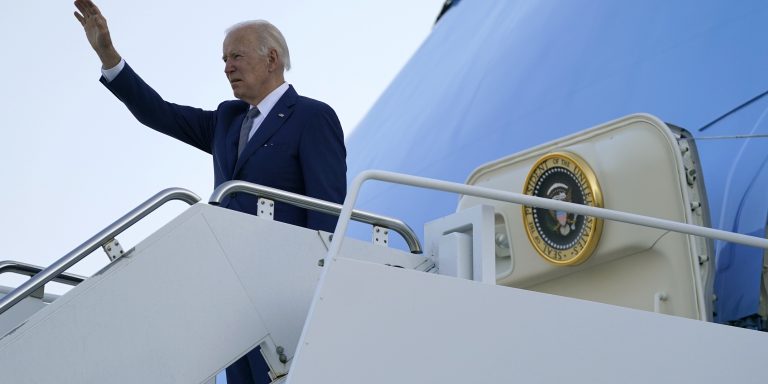INTELBRIEF
May 27, 2022
IntelBrief: Biden’s Asia Trip Reveals Myriad Foreign Policy Challenges on Agenda

Bottom Line Up Front
- U.S. President Joseph Biden recently returned from Asia, where he sought to reassure allies and send a message to China that Washington would not shrink from its efforts to provide security and stability in the region.
- In the background of the visit were U.S. efforts to shape a strategy to counter the rise of China, an already high priority that has assumed an even greater sense of urgency over the last few months.
- The Biden administration has remained cautious about engaging with Pyongyang, in somewhat stark contrast to the Trump administration’s aggressive, yet ultimately fruitless, outreach.
- Between the threat posed by Kim Jong Un’s unpredictable regime, cross-strait tensions, and the need to signal commitment to allies in the Indo-Pacific, the Biden administration has myriad foreign policy challenges on its agenda.
U.S. President Joseph Biden recently returned from a trip to Asia where he sought to reassure allies and send a message to China that Washington would not shrink from its efforts to provide security and stability in the region. While Biden’s comment that the U.S. would indeed defend Taiwan in the event of a Chinese military invasion garnered significant media attention, it was the quiet diplomacy conducted behind the scenes that will prove most consequential in shaping the future of U.S. involvement in the region. U.S. Secretary of State Antony Blinken delivered remarks yesterday that attempted to clarify the Biden administration’s approach toward China. While avoiding too many specifics, Blinken suggested that the Biden administration’s strategy would continue to focus on promoting democracy and innovation, bolstering allies in the region, and competing aggressively with China—economically, militarily, and politically. In light of Russia’s poor military performance in Ukraine and its potential economic subordination to Chinese markets, some observers have suggested that the era of great power competition may be short lived, supplanted by a new bipolar international system dominated by the United States and China.
The Russian invasion of Ukraine continued to loom large over the President’s trip, particularly as Washington attempted to show unity with other allies and partners in the Indo-Pacific region, including Japan, India, and Australia, at the second in-person Leaders’ Summit of the Quadrilateral Security Dialogue, more commonly referred to as the “Quad.” President Biden unveiled a new economic initiative, known as the Indo-Pacific Economic Framework, which fell short of expectations for several Asian allies, who expressed frustration at the plan’s lack of tariff reductions and expanded market access. Japan’s Prime Minister, Fumio Kishida, appealed to President Biden to consider rejoining the Trans-Pacific Partnership (TPP), which the U.S. suddenly withdrew from in 2017. The U.S., however, is unlikely to recommit to the trade pact in light of domestic pushback from across the political spectrum. In spite of this, Japan remains a steadfast ally to the U.S. and has assumed a far more proactive role than expected in providing security assistance to Ukraine. Washington continues to see Tokyo as a crucial partner on numerous security, economic, and diplomatic issues.
In the background of the visit were U.S. efforts to shape a strategy to counter the rise of China, an already high priority that has assumed an even greater sense of urgency over the last few months. There are also growing concerns over the instability caused by North Korea. Pyongyang’s saber rattling has not gone unnoticed, and it remains unclear what the Biden administration’s strategy is to deal with the mercurial dictator Kim Jong Un. On Wednesday, hours after U.S. President Biden concluded his trip, North Korea tested an intercontinental ballistic missile (ICBM), in addition to two other missile launches, believed to have been short-range ballistic missile (SRBM) tests. During his trip to Asia, Biden met with Yoon Suk Yeol, South Korea’s new president, where discussions focused on joint military drills between U.S. and Republic of Korea (ROK) forces.
Further complicating the situation in North Korea are reports of a coronavirus crisis rocking the hermit kingdom. Widespread malnutrition and the presence of tuberculosis within the country heighten the risks posed by coronavirus to the North Korean population. The Biden administration has mostly remained cautious about engaging with Pyongyang, in somewhat stark contrast to the Trump administration’s aggressive, yet ultimately fruitless, outreach. The Biden administration’s approach has been compared to that of the Obama administration, characterized as “strategic ambiguity” and avoiding escalation. Between the threat posed by Kim Jong Un’s unpredictable regime, the rise of China and cross-strait tensions, and the need to signal a renewed commitment to allies in the Indo-Pacific, the Biden administration has myriad foreign policy challenges on its agenda. Russia’s belligerence in Ukraine is understandably occupying significant U.S. bandwidth, but the Administration has been keen to emphasize that its support to Kyiv will not distract from other pressing issues, including U.S. foreign and security policy in Asia.